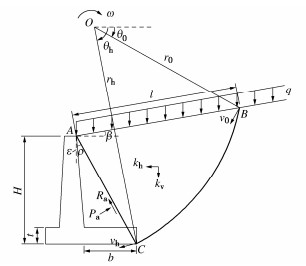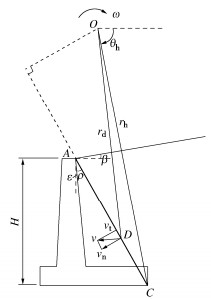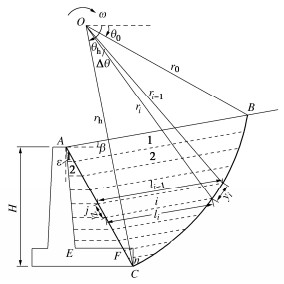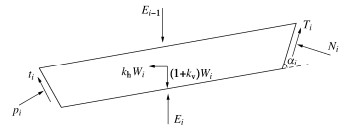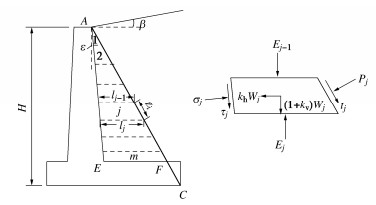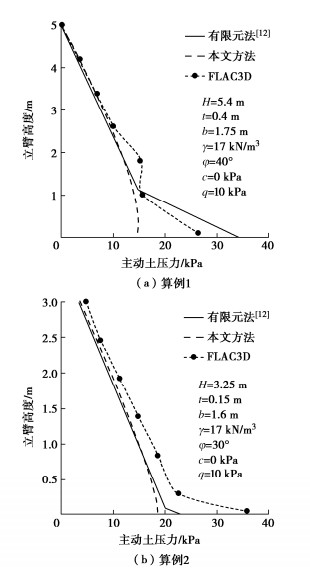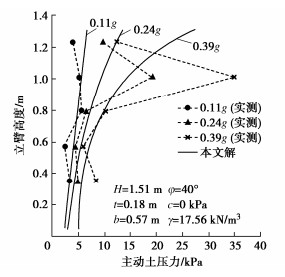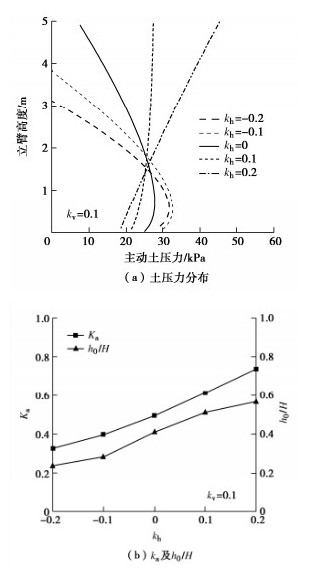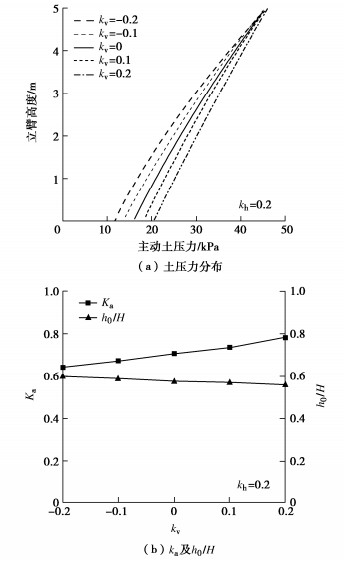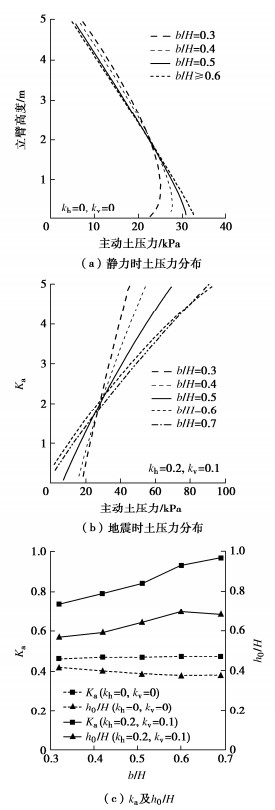Method for calculating seismic active earth pressures on cantilever retaining walls
-
摘要: 为确定悬臂式挡土墙立臂的地震主动土压力,针对墙后填土的5种可能失稳破坏模式,基于对数螺旋式滑裂面形态,采用极限分析上限定理与拟静力法推导了作用于假想坦墙背上的地震土压力合力;在此基础上,对坦墙背后滑楔体、立臂与坦墙背之间的土体分别采用斜条分与水平条分法,并通过土压力合力的上限解对坦墙背上的土压应力进行修正,进而求得立臂上的土压力分布。实例分析表明,立臂静土压力沿深度分布呈顶点位于下部的抛物线模式;地震土压力分布一般呈非线性递减模式,计算值与试验值有良好的一致性;两种工况下合力作用点分别位于立臂下半段与上半段。参数分析显示,水平地震影响系数、踵板宽度和立臂倾角的增加均使立臂中上部地震主动土压力显著增大;地震条件下增长踵板宽度会导致立臂受力增加。在强震条件下,本法得到的立臂土压力比铁路规范法的结果高出约9%~14%,立臂底端弯矩更显著高于规范法结果,规范法进行强震条件下悬臂墙的抗震设计可能偏于不安全。Abstract: In order to determine the seismic active earth pressures on the stem of a cantilever wall, the resultant of the earth pressures on the assumed plane wall back is firstly derived using the upper-bound limit analysis and the pseudo-static method for five types of potential failure modes based on the log-spiral slip surface. The oblique and horizontal slice methods are secondly adopted respectively for the slide wedge mass and the local soils between the stem and the plane wall back to determine the earth pressure distribution on the stem, in which the earth pressure on the plane wall back are calibrated by the upper bound solution for the resultant of earth pressures. Some examples show that the proposed distribution of the earth pressures on the stem with depth takes on a parabolic profile with the peak point on the lower segment of the stem under the static condition, whereas it presents a nonlinear decreasing mode fairly identical with the test results under the seismic condition. The application point of the resultant is located on the lower and upper segments of the stem under the static and seismic conditions, respectively. The parameter study shows that the increase of horizontal seismic coefficient, heel plate width and stem back inclination induces a significant increase of the seismic active earth pressures on the middle and upper segments of the stem. Under the seismic condition, broadening the width of heel plate can cause the increase of the stresses on the stem. In particular, the proposed earth pressures on the stem are 9%~14% higher than those by China's code for design of retaining structures of railway earth works under strong earthquakes, and the proposed bending moments at the stem bottom are noticeably greater than those by the above code, which naturally means the Norm is not safely suitable for the aseismic design under strong earthquakes.
-
-
图 2 模式Ⅰ相应的旋转破坏机构
Figure 2. Rotational failure mechanism of Mode Ⅰ in Fig. 1
-
[1] 铁路路基支挡结构设计规范: TB 10025—2019[S]. 北京: 中国铁道出版社, 2019. Code for Design of Retaining Structures of Railway Earthworks: TB 10025—2019[S]. Beijing: China Railway Publishing House, 2019. (in Chinese)
[2] 李海光. 新型支挡结构设计与工程实例[M]. 2版. 北京: 人民交通出版社, 2011. LI Haiguang. Design and Engineering Example of New Retaining Structure[M]. 2nd ed. Beijing: China Communications Press, 2011. (in Chinese)
[3] BARGHOUTHI A F. Active earth pressure on walls with base projection[J]. Journal of Geotechnical Engineering, 1990, 116(10): 1570-1575. doi: 10.1061/(ASCE)0733-9410(1990)116:10(1570)
[4] GRECO V R. Analytical active earth thrust on cantilever walls with short heel[J]. Canadian Geotechnical Journal, 2008, 45(12): 1649-1658. doi: 10.1139/T08-078
[5] GRECO V R. Seismic active thrust on cantilever walls with short heel[J]. Soil Dynamics and Earthquake Engineering, 2009, 29(2): 249-252. doi: 10.1016/j.soildyn.2008.03.003
[6] KARKANAKI A R, GANJIAN N, ASKARI F. Stability analysis and design of cantilever retaining walls with regard to possible failure mechanisms: an upper bound limit analysis approach[J]. Geotechnical and Geological Engineering, 2017, 35(3): 1079-1092. doi: 10.1007/s10706-017-0164-5
[7] ALPER KAMILOĞLU H, SADOĞLU E. Experimental and theoretical investigation of short- and long-heel cases of cantilever retaining walls in active state[J]. International Journal of Geomechanics, 2019, 19(5): 1-17.
[8] CHEN F Q, ZHANG Y B, LIN Y J, et al. Active earth pressure against inverted T-type retaining walls under translation mode[J]. International Journal of Geomechanics, 2021, 21(6): 04021077. doi: 10.1061/(ASCE)GM.1943-5622.0002013
[9] EVANGELISTA A, SCOTTO D S A, SIMONELLI A L. Evaluation of pseudostatic active earth pressure coefficient of cantilever retaining walls[J]. Soil Dynamics and Earthquake Engineering, 2010, 30(11): 1119-1128. doi: 10.1016/j.soildyn.2010.06.018
[10] SCOTTO DI SANTOLO A, EVANGELISTA A. Dynamic active earth pressure on cantilever retaining walls[J]. Computers and Geotechnics, 2011, 38(8): 1041-1051. doi: 10.1016/j.compgeo.2011.07.015
[11] 李志浩, 肖世国. 地震条件下悬臂式挡墙主动土压力的极限分析方法[J]. 中国地质灾害与防治学报, 2020, 31(5): 79-87. https://www.cnki.com.cn/Article/CJFDTOTAL-ZGDH202005012.htm LI Zhihao, XIAO Shiguo. Limit analysis method of active earth pressure on cantilever retaining wall subjected to earthquake[J]. The Chinese Journal of Geological Hazard and Control, 2020, 31(5): 79-87. (in Chinese) https://www.cnki.com.cn/Article/CJFDTOTAL-ZGDH202005012.htm
[12] 戴自航, 林智勇, 郑也平, 等. L型挡土墙主动土压力计算的基底摩擦系数折减有限元法[J]. 岩土工程学报, 2009, 31(4): 508-514. http://manu31.magtech.com.cn/Jwk_ytgcxb/CN/abstract/abstract13209.shtml DAI Zihang, LIN Zhiyong, ZHENG Yeping, et al. Finite element method for computations of active earth pressures acting on L-shaped retaining walls with reduced friction coefficients of base bottoms[J]. Chinese Journal of Geotechnical Engineering, 2009, 31(4): 508-514. (in Chinese) http://manu31.magtech.com.cn/Jwk_ytgcxb/CN/abstract/abstract13209.shtml
[13] CHUGHASHOK K, LABUZJOSEPH F. Numerical simulation of an instrumented cantilever retaining wall[J]. Canadian Geotechnical Journal, 2011, 48(9): 1303-1313. doi: 10.1139/t11-037
[14] 高洪梅, 卜春尧, 王志华, 等. 回填EPS混合土的防滑悬臂式挡墙地震稳定性分析[J]. 岩土工程学报, 2017, 39(12): 2278-2286. http://manu31.magtech.com.cn/Jwk_ytgcxb/CN/abstract/abstract17241.shtml GAO Hongmei, BU Chunyao, WANG Zhihua, et al. Seismic stability of anti-sliding cantilever retaining wall with EPS composite soil[J]. Chinese Journal of Geotechnical Engineering, 2017, 39(12): 2278-2286. (in Chinese) http://manu31.magtech.com.cn/Jwk_ytgcxb/CN/abstract/abstract17241.shtml
[15] JO S B, HA J G, LEE J S, et al. Evaluation of the seismic earth pressure for inverted T-shape stiff retaining wall in cohesionless soils via dynamic centrifuge[J]. Soil Dynamics and Earthquake Engineering, 2017, 92: 345-357. doi: 10.1016/j.soildyn.2016.10.009
[16] 肖世国. 似土质边(滑)坡抗滑桩后滑坡推力分布模式的近似理论解析[J]. 岩土工程学报, 2010, 32(1): 120-123. http://manu31.magtech.com.cn/Jwk_ytgcxb/CN/abstract/abstract11907.shtml XIAO Shiguo. Approximate theoretical solution of distribution modes of landslide thrust on anti-sliding piles in soil-like slopes or landslides[J]. Chinese Journal of Geotechnical Engineering, 2010, 32(1): 120-123. (in Chinese) http://manu31.magtech.com.cn/Jwk_ytgcxb/CN/abstract/abstract11907.shtml
[17] GERAILI MIKOLA R, CANDIA G, SITAR N. Seismic earth pressures on retaining structures and basement walls in cohesionless soils[J]. Journal of Geotechnical and Geoenvironmental Engineering, 2016, 142(10): 1–9.
[18] CANADIAN GEOTECHNICAL SOCIETY. Canadian Foundation Engineering Manual[M]. Richmond: BiTech Publisher Ltd., 2006.
[19] XIAO S G, YAN Y P, XIA P. General solution for active earth pressure on rigid walls under strip surcharge on retained soils using variational method[J]. International Journal of Civil Engineering, 2021, 19: 881–896. doi: 10.1007/s40999-020-00579-4
[20] 陈建功, 胡日成, 许明. 考虑合力作用点位置的主动土压力计算[J]. 工程力学, 2016, 33(11): 132-139. https://www.cnki.com.cn/Article/CJFDTOTAL-GCLX201611015.htm CHEN Jiangong, HU Richeng, XU Ming. Active earth pressure calculation considering force point location[J]. Engineering Mechanics, 2016, 33(11): 132-139. (in Chinese) https://www.cnki.com.cn/Article/CJFDTOTAL-GCLX201611015.htm
[21] CHEN W F. Limit analysis and soil plasticity[M]. Amsterdam; New York: Elsevier Scientific Pub. Co. 1975.
[22] LIN Y L, LENG W M, YANG G L, et al. Seismic active earth pressure of cohesive-frictional soil on retaining wall based on a slice analysis method[J]. Soil Dynamics and Earthquake Engineering, 2015, 70: 133-147.
[23] 李傲赢. 加筋悬臂式复合支挡结构振动台模型试验研究[D]. 成都: 西南交通大学, 2019. LI Aoying. Study of Shaking Table Test for Reinforced Cantilever Composite Retaining Structure[D]. Chengdu: Southwest Jiaotong University, 2019. (in Chinese)
[24] BENTLER J G, LABUZ J F. Performance of a cantilever retaining wall[J]. Journal of Geotechnical and Geoenvironmental Engineering, 2006, 132(8): 1062-1070.
[25] 朱宏伟, 姚令侃, 赖军. 基于性能的重力式挡墙地震易损性分析[J]. 岩土工程学报, 2020, 42(1): 150-157. http://manu31.magtech.com.cn/Jwk_ytgcxb/CN/abstract/abstract18106.shtml ZHU Hongwei, YAO Lingkan, LAI Jun. Seismic vulnerability assessment of gravity retaining walls based on performance[J]. Chinese Journal of Geotechnical Engineering, 2020, 42(1): 150-157. (in Chinese) http://manu31.magtech.com.cn/Jwk_ytgcxb/CN/abstract/abstract18106.shtml
-
其他相关附件




 下载:
下载:
